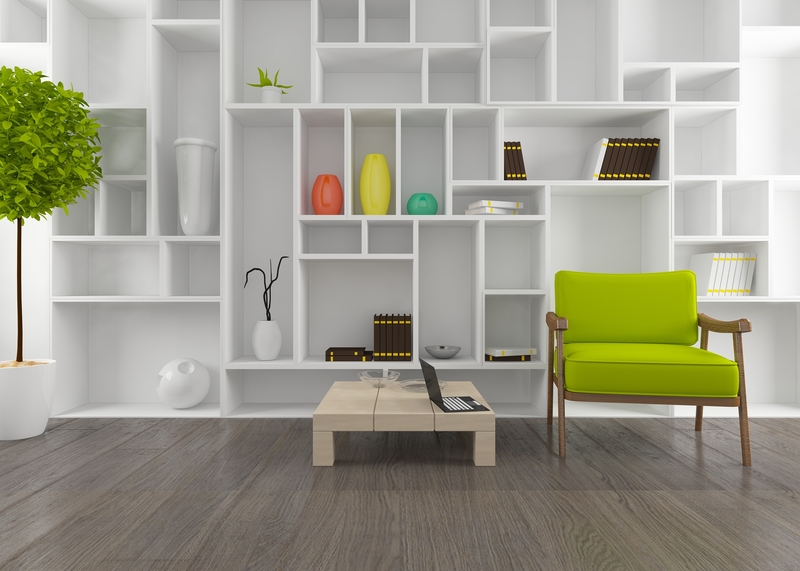Discover the Best Way to Move Your Bed and Mattress
Posted on 25/05/2025
Discover the Best Way to Move Your Bed and Mattress
Relocating to a new home can be an exciting journey, but when it comes to moving your bed and mattress, the task suddenly feels daunting. These bulky, heavy, and essential pieces require careful planning to ensure a smooth and damage-free transition. In this comprehensive guide, you will learn the best strategies, tools, and tips for successfully and efficiently moving your bed and mattress. Whether you're hiring professional movers or handling the move DIY-style, this article will empower you to make the smartest decisions for your move.

Why Properly Moving Your Bed and Mattress Matters
Your bed is where you find rest and rejuvenation. Ensuring it arrives in perfect condition at your new place is not just about convenience--it's about safeguarding your health, comfort, and your investment. Mattresses and beds are surprisingly delicate: mishandling can lead to broken frames, torn upholstery, or warped mattresses, all of which can result in poor sleep quality and costly replacements.
- Protect Your Investment: High-quality mattresses and bed frames aren't cheap. Moving them carefully helps preserve their value and lifespan.
- Ensure Quality Sleep: Damaged beds or mattresses can impact your rest negatively.
- Save Money: Avoid additional expenses from repairs or replacements caused by improper handling.
Key Considerations Before Moving Your Bed and Mattress
- Size and Weight: Beds and mattresses come in various sizes and weights, influencing how you should move them.
- Type of Bed Frame: The process will differ if you have a platform, sleigh, adjustable, or metal bed frame.
- Distance of Move: Local and long-distance moves require different preparations.
- Resources Available: Will you use a moving company or rent a truck and handle it yourself?
Step-by-Step Guide: The Best Way to Move a Mattress and Bed
1. Gather Essential Supplies
Before you disassemble anything, ensure you have these indispensable moving supplies:
- Mattress Bag or Cover: Protect your mattress from dirt, moisture, and tears during the move.
- Furniture Sliders: Make shifting heavy pieces easier without scratching floors.
- Moving Blankets: Prevent dings and scratches on bed frames and headboards.
- Ratchet Straps or Ropes: Secure your items in the moving vehicle.
- Tool Kit: For bed frame disassembly (include screwdrivers, Allen wrenches, pliers).
- Plastic Baggies: Store bolts, screws, and small pieces safely.
- Hand Truck or Dolly: For heavy lifting, especially with large mattresses.
- Labels & Marker: For organizing small hardware and bed frame parts.
2. Take Comprehensive Measurements
Always measure your mattress, bed frame, doorways, staircases, and hallways before moving. This step is often overlooked and results in unnecessary headaches. Will your mattress or frame fit through the doors and up the stairs? Knowing in advance helps avoid unexpected, time-consuming obstacles.
3. Disassemble the Bed Frame
- Strip Bedding: Remove all pillows, blankets, sheets, and place them in clearly labeled boxes or linens bags.
- Remove the Mattress: Lift the mattress carefully, ideally with another person, and wrap it in a mattress cover or heavy-duty plastic bag to shield it from dirt and moisture.
- Take the Bed Apart: Refer to the manufacturer's instructions if available. Remove slats or support boards first, then headboard and footboard. Certain beds require the removal of central beams or legs.
- Organize Hardware: Place all screws, bolts, and small pieces in a labeled bag and tape it to a large piece of the frame or keep it in your essentials box.
Disassembling your bed makes moving parts safer, manageable, and far less likely to break.
4. Prepare the Mattress for Moving
- Encase Mattress: Slide the mattress into a fitted mattress bag or securely wrap with plastic sheeting. This is the best way to move your mattress without damage or stains.
- Seal the Bag: Tape any open edges closed to avoid unwanted debris or bugs entering during transport.
- Label Clearly: Note the size (Queen, King, etc.) and owner if moving for multiple people or families.
5. Move the Bed Frame and Mattress Safely
Lifting Techniques: When moving large, heavy items like a bed, always prioritize safety. Bend with your knees, keep your back straight, and lift with your legs, not your back. For unwieldy mattresses, two people should carry it--one at each end.
- Use Furniture Sliders: For short distances, especially across flooring inside your home.
- Hand Truck or Dolly: Ideal for carrying mattresses and bed frame pieces down stairs or into a moving truck.
- Don't Drag: Never drag mattresses or bed components, as it can tear the fabric or damage the floor.
6. Loading Into a Moving Truck
- Place Mattress Flat: If possible, lay mattresses flat inside the truck to prevent damage to internal springs or memory foam structure. If space is tight, set it upright along the truck wall and secure with ratchet straps or ropes.
- Protect Bed Frame: Wrap parts in moving blankets or pads. Secure pieces to prevent shifting during transit.
- Stack Thoughtfully: Don't place heavy items on top of mattresses or delicate bed pieces. If moving other furniture, organize strategically to maximize space and reduce potential damage.
7. Reassembling Your Bed and Mattress
Once you arrive at your new home, unpack the mattress and bed components first so your sleeping space is ready after a long day of moving. Reassemble the frame, following the reverse order of your disassembly. Use the labeled hardware bag to find screws and bolts easily. Place the mattress on the frame, allow it to air out for a few hours, and re-make with your clean bedding.
Best Practices for Moving Different Mattress Types
Memory Foam and Latex Mattresses
- Do Not Bend: These mattresses can lose shape if bent; keep them flat and upright when possible.
- Use a Firm Mattress Bag: Memory foam is heavier and more flexible than traditional spring mattresses, so ensure a tight fit to prevent sagging or stretching.
Hybrid and Innerspring Mattresses
- Flat Placement: Laying them flat avoids unwanted coil distortion.
- Extra Padding: Protect both sides with moving blankets for enhanced protection.
Box Springs
- Wrap Carefully: Box springs have delicate fabric and wooden frames; secure with a sturdy cover.
- Handle Gently: Dropping or bumping can cause structural damage.
Using Professional Movers vs. Moving Your Bed and Mattress Yourself
Depending on your budget, physical ability, and comfort, you must decide if hiring professional movers is worth it or if you'll handle the move yourself. Here are key pros and cons to help in your decision:
Pros of Hiring Professionals for Mattress and Bed Moves
- Expertise: Movers have experience in maneuvering large or fragile items.
- Equipment: They provide moving trucks, mattress bags, and other tools needed for safe handling.
- Reduced Risk: Less chance of injury or damage to your property.
- Insurance: Your bed and mattress may be covered by moving insurance in case of an accident.
Cons of Hiring Movers
- Cost: Professional moving services can be expensive, especially for long-distance or full-service moves.
- Scheduling: You must coordinate dates and times, which might limit your flexibility.
- Less Control: If you have custom instructions or sentimental pieces, overseeing the move personally may be preferred.
Doing It Yourself: Tips for a Successful Bed and Mattress Move
- Enlist Friends or Family: Two or more people make the job easier and safer.
- Plan Ahead: Prepare all tools and wrapping materials prior to moving day.
- Rent the Right Vehicle: Choose a van or truck with enough space for your mattress to lay flat if possible.
- Take Breaks: Avoid fatigue-induced errors or accidents.
- Protect Your Back: Use proper lifting techniques or invest in moving straps.
The Best Tools to Move Your Bed and Mattress Easily
Selecting the right equipment streamlines the process and protects both your furniture and your safety. Here are moving essentials:
- Mattress Moving Straps: Ergonomic straps that help distribute mattress weight more evenly, reducing strain and making carrying easier.
- Plastic Bed Covers: Thick and durable, these shield your materials from dirt, rain, and tears.
- Heavy-Duty Dolly: Use a furniture dolly with straps to move the bed frame and mattress effortlessly, especially for long hallways or driveways.
- Moving Blankets: Essential for wrapping wooden or upholstered bed frames to avoid scratches and dents.
Common Mistakes to Avoid When Moving Your Mattress and Bed
Even the most well-prepared movers can make slip-ups. Watch out for these common pitfalls:
- Skipping the Mattress Bag: Exposed mattresses easily collect stains and tears during moves--always use a cover.
- Improper Disassembly: Not removing all hardware or not labeling parts often leads to missing pieces at the new home.
- Dragging Items: Dragging beds and mattresses, especially up or down stairs, increases risk of material and structural damage.
- Poor Packing in the Truck: Placing heavy items on top of mattresses can permanently deform their structure.
- Ignoring Your Body: Attempting to carry too much weight yourself encourages injury--don't hesitate to ask for help or use lifting aids.
Eco-Friendly Tips for Moving Your Bed and Mattress
If you want to move your mattress and bed sustainably, consider these steps:
- Reuse Packaging Materials: Save plastic bags, blankets, and foam sheets for future use rather than discarding them after the move.
- Donate or Recycle Old Mattresses: If replacing your bed, research local mattress recycling programs or donate gently used items to shelters.
- Opt for Digital Manuals: Download digital bed frame assembly instructions instead of printing out materials.

Frequently Asked Questions About Moving Beds and Mattresses
Can You Fold a Mattress for Moving?
Most foam mattresses (especially thinner ones) can be bent or folded for short periods. However, interspring and hybrid mattresses should never be folded as it can damage the internal structure. Always consult your mattress manufacturer's guidelines first.
Is It Okay to Move a Mattress on Top of a Car?
While not recommended, it's sometimes possible with small mattresses and short distances. Secure the mattress firmly with ratchet straps--not ropes--to prevent sliding or flying off. Never transport large or heavy mattresses this way for safety reasons.
How Do You Move a Bed Up or Down Stairs?
Disassemble the bed as much as possible and use a dolly or hand truck for the mattress. Take it slowly, ensuring you have enough assistance and that the path is clear of obstacles.
Conclusion: Mastering the Best Way to Move Your Bed and Mattress
Moving your bed and mattress doesn't have to be an overwhelming task when you have the right plan and tools in place. By taking careful measurements, using quality protective materials, applying smart lifting techniques, and perhaps enlisting professional help, you can enjoy peace of mind knowing your sleeping sanctuary is transported safely to your new space. Remember, investing a bit of time and effort in proper preparation pays off in comfort, savings, and a seamless moving day. Follow these tips, and discover the best way to move your bed and mattress with ease and confidence!
- Plan ahead and gather all needed supplies early.
- Disassemble and protect all components for safer transport.
- Enlist help for the heavy lifting.
- Pack smart to make reassembly fast and simple in your new home.
Ready for your big move? Keep this complete guide handy as you prepare to transition to your next home, and your bed and mattress will thank you for years of restful sleep ahead!






